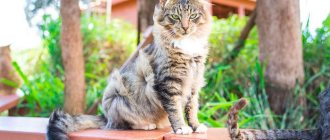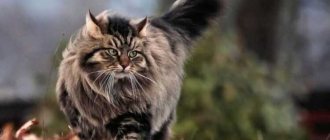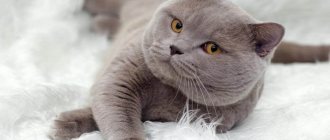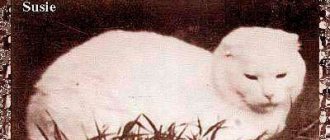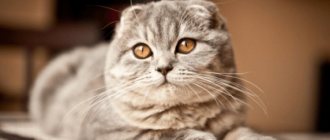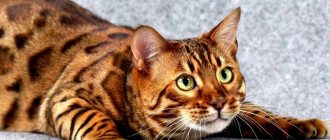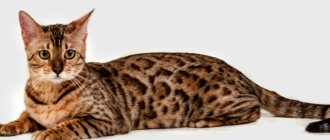If you look into history, you can also find images of cats in rock paintings. There is a version that the ancient Egyptians tamed wild animals from the cat family. The coexistence of cats and humans began about 10-15 thousand years ago. According to one version, the ancestor of the first domestic cat was the North African steppe cat; it was domesticated in Nubia, after which the animals began to be imported to Egypt and Asia. It was there that interbreeding with wild Bengal species occurred.
Cats: history of appearance
Many argue that the ancient Egyptians were the first to tame and domesticate cats, but there is no general consensus on this matter.
It is believed that the history of the appearance of cats next to humans begins approximately 10-12 thousand years ago and is due to the fact that these animals became close to people precisely from the time when the latter began to lead a sedentary lifestyle. This, by the way, makes cats simply unique among all animals, many of which still try to stay away from people. The history of the origin of cats, which is also very controversial, also causes a lot of controversy. The most common opinion, which, by the way, has especially taken root in Russia, is that the single ancestor of modern cats is the Western Asian North African steppe cat, which was domesticated not in Egypt, but in Nubia, and this happened about 4 thousand years ago. Only after this did cats come to Egypt, and then appeared in Asia, where they successfully crossed with forest Bengal species.
Read more
Theory of the origin of cats
Cats belong to the carnivorous mammals of the cat family. According to scientists, approximately 600 million individuals have been domesticated in the modern world. The history of modern cats is closely connected with forest and steppe representatives of the cat family. The term cat itself comes from the Latin “cattus”; in the Old Russian language there was a name “kotka”.
There are two versions about the origin of cats. According to one of the biblical legends, rodents appeared on Noah’s Ark during the Flood, which other animals could not cope with. Then the lions gave birth to cats, which, thanks to their small size and dexterity, were able to catch all the rats and mice.
According to the second version, the first wild cats inhabited the planet more than 60 thousand years ago. The ancestor of the cat family is considered to be the Fossu, an ancient species that lived in Madagascar. There is another scientific opinion that has a right to exist - the ancestor of modern seals was Proailurus, which existed approximately 25 million years ago on the territory of Eurasia.
The weight of Proailurus was about 9 kg, the animal had a dense build, short limbs and an elongated body with a long tail. Sharp, half-retractable claws made it possible to spend most of the time not on the ground, but in trees. This way of life helped to escape from large predators.
It is believed that many lineages of cats, including saber-tooths, originated from Proailurus. He was the progenitor of a suborder including hyenas, civets and cats of prey.
Cats in history: secrets of centuries
The fact that we owe the appearance of cats to Ancient Egypt is almost no secret. It is this country that is officially considered the birthplace of these wonderful animals, and it was this country that was once famous for the cult of cats, some forms of which have survived to this day. However, cats in history managed to prove themselves outside the Egyptian borders, and in a short time spread throughout the world.
This spread became possible thanks to the Phoenicians. They were the first to take cats on sea voyages, and it was thanks to them that the whole world learned about the domestic cat. The ancient Greeks were especially grateful: cats (which were smuggled into Greece!) helped them so well in the fight against rodents that the Greeks later made the freedom-loving cat a symbol of the famous uprising of Spartacus. Well, from Greece cats came to Georgia, and then to the entire European market.
Read more
Details of the distribution of cats around the globe
Ancient Egypt is officially considered the birthplace of cats. There was even a cult of cats. These animals were worshiped as they were considered a symbol of the Sun and fertility. By an imperial decree in 390, the cult of the goddess Bastet, depicted as a woman with a cat's head and the embodiment of female beauty, joy, fertility, hearth and cats, was prohibited. Since then, pets have ceased to be an object of worship in temples, but continued to exist peacefully in the homes of Egyptians.
Cats quickly spread throughout the world. The Phoenicians took part in this process, regularly making sea voyages. They always took cats on board with them to protect their provisions from mice and rats. The cats that came to Greece deserved special gratitude from the local population. They helped cope with hordes of rats and mice, which is why they were made a symbol of the Spartacus uprising.
The cat's travels around the world continued, the next country was Georgia, and then they conquered the entire European market. The remains of a domesticated cat found in Britain date back to the 4th century BC. A law was even passed on the issue of keeping pets in houses and their protection, after which animals settled next to people in dwellings and monasteries.
Information about cats that settled in Rus' dates back to the 7th century BC. They were brought to Russian lands by warriors and traders. Animals were revered not only by ordinary people, they were under church protection. Not everyone could buy a kitten, because the price for a pet was prohibitively high.
Historical events of the Middle Ages
Cats quickly multiplied all over the earth, so they lost their privileged position. The clergy changed their minds about pets, and active persecution of cats began. Killing and torturing animals became commonplace. Even in England, where cats were adored, they were actively burned at the stake, considered the personification of evil spirits.
In America, people who kept pet cats were considered minions of evil forces, so they had to choose: keep the cat and be bullied, or kick out the pet and suffer from mouse attacks.
Renaissance
During the Renaissance, cats began to re-conquer human habitations. In the 18th century, cat baiting stopped and people began holding exhibitions of these animals. The creation of new breeds with certain characteristics necessary for humans was initiated.
Nowadays pets are very popular. Almost every fourth family has one or even several kittens. Thanks to breeding work, dozens of new breeds have been developed, so purchasing a suitable pet for the family will not be difficult.
History of cats in Egypt
The history of Egypt is very closely connected with cats, because it is believed that it was the Egyptians who were the first to domesticate these animals, and their importance in the life of the country was simply enormous. In addition, some researchers believe that the domestic cat first appeared in ancient Egypt - as a result of crossing the jungle cat and Euro-African wild cats.
In general, the history of Egyptian cats begins in the second millennium BC: the oldest image of domestic cats that has been found dates back to this time. The reason why these unique animals occupied such an important place in the history of Egypt is simple: from time immemorial this state was agricultural, and it was cats that could save its crops from rodents.
However, in the history of Egypt, cats were not only “overseers” of grain, but also hunters: they were specially trained so that they could hunt feathered game, and in addition, these animals successfully hunted small rodents, moles, and sometimes even hares.
Read more
How did domestic cats appear?
Kirill Stasevich, biologist
“Science and Life” No. 8, 2017
Photo: Larazoni / Wikimedia Commons
The ancient Egyptians had a special relationship with cats: they were revered as sacred animals; mummified like people; depicted in sculpture and frescoes. And the very first cat “portrait” was painted by the Egyptians. It was a painting in one of the tombs south of Cairo, made around 1950 BC. e., that is, almost four thousand years ago. It shows a cat staring intently at an approaching rat.
Cat mummies. Exhibits from the British Museum. Photo: britishmuseum.org
For quite a long time it was believed that the Egyptians tamed cats. However, in 2004, a burial dating back to 9500 BC was discovered in Cyprus. e., in which a cat was found along with a man. A wild animal would hardly be put in a grave. It turned out that cats lived with people long before they appeared in Egypt. The Middle East began to be considered the homeland of domestic cats, and for some time they forgot about Egypt. But not for long: in 2008, a burial was discovered in the south of Egypt, in which they found six cats - a male, a female and four kittens. Although this burial was younger than the Cypriot burial (about 6,000 years), it became clear that cats were known in Egypt much earlier than was believed until recently.
It is known that the ancestor of the domestic cat was the steppe cat Felis silvestris lybica
- it still lives in the steppe, desert and partly mountainous regions of Africa, Western, Middle and Central Asia, Northern India, Transcaucasia and Kazakhstan. In 2007, it was established that all modern cats originated from him.
The ancestor of the domestic cat is the steppe cat, which has a “wild” tabby coloration. Photo: Sonelle at English / Wikipedia / CC BY-SA 3.0
Bast, or Bastet. In Ancient Egypt, the goddess of joy, fun and love, fertility and hearth. She was depicted as a woman with the head of a cat. Picture: Gunkarta / Wikimedia / CC BY-SA 3.0
Over time, domestic cats accumulated certain changes in their genome, and if we trace how and when such changes occurred using ancient animal remains, we can determine exactly where domestic cats first appeared and how they spread across the globe.
This is exactly what Eva-Maria Geigl and Thierry Granger from the Jacob Monod Institute (France) tried to do, together with colleagues from scientific centers in Australia, Armenia, Romania, Germany and other countries. They analyzed more than two hundred DNA samples taken from the remains of cats ranging in age from 100 to 9,000 years old, which were found during archaeological excavations in Europe, Africa and the Middle East. For the analysis, we used not ordinary nuclear DNA, but the one contained in mitochondria. Mitochondrial DNA is transmitted only through the maternal line, since after fertilization the embryo retains only those mitochondria that were in the egg. Using such DNA, it is relatively easy to reconstruct the female line of the family tree, without being distracted by paternal genes.
Tricolor cat: white, black and red. Photo by Marina Slyusar
The steppe cat has its own “mitochondrial portrait” - characteristic features in the mitochondrial DNA that distinguish it from other related species. In an article published in the journal Nature Ecology & Evolution
, it is reported that for the first time domestic cats, most similar in mitochondrial genome to the steppe cat, appear 9,000 years ago in burials excavated in the territory of modern Turkey. And this is quite consistent with the “Middle Eastern” hypothesis: it was in these places, about 10,000 years ago, that wild cats discovered that near food supplies made by humans, rodents were found in abundance and that it was therefore better to be friends with people. The mitochondrial profile of such cats was called “type A”. Approximately 4400 BC. e. cats of this type appear on the territory of modern Bulgaria, 3200 BC. e. - where Romania is now, and then they spread throughout the rest of Europe, Asia and Africa. Since cats are characterized by territoriality and are not inclined to long journeys, animals were obviously able to quickly settle on all continents only with the help of people.
But let's return to Egypt. It turned out that the mitochondrial DNA of Egyptian cat mummies differs from the DNA of “type A” cats. "Egyptian women" were designated "type C", and the first of them date back to around 800 BC. e. It is possible that “type C” cats appeared in Egypt earlier, but it was not possible to extract the amount of DNA required for analysis from more ancient burials.
The Egyptian Mau is an ancient breed that has undergone natural selection. Her appearance has not undergone significant changes for 3000 years. In the photo: Egyptian Mau of silver color. Photo: Lil Shepherd / Wikipedia / CC BY 2.0
Bicolor domestic cat. Photo by Ekaterina Krichmar
Over time, Egyptian cats became very popular: by the fifth century AD they could be found throughout Europe and throughout the Mediterranean, and by the end of the first millennium in some places they completely replaced Middle Eastern cats. The popularity of “type C” cats can be explained by the notorious special attitude of the Egyptians towards these animals: there were more and more cats in Egypt, and here among them, which is especially important, they selected not only good hunters, but also pleasant “roommates” who had gotten rid of the wild quarrelsomeness. The changes that gradually took place in Egyptian cats can also be traced in Egyptian art: at first the animals were depicted doing some useful activity, such as catching rats, but then the cats in the paintings became more and more “domesticated” and became closer to people - they already caught with their owners birds, they have collars, they sit under the chair while people are busy having lunch, as in one of the frescoes dating back to about 1500 BC. e.
Siamese color. A cat's paws, tail, head and ears are usually darker in color. Photo by Alexey Karpushin
But where did the “type C” cat come from in Egypt? It can be assumed that the Egyptians domesticated cats independently of other peoples, taking as a basis the local population of steppe cats, whose mitochondrial DNA, after domestication from scratch, gave “type C” - in this case, local domestic cats originated here. But it could have been different: first, Middle Eastern “type A” cats appeared in Egypt, which later, as a result of crossing with local wild cats, turned into “type C” cats. And subsequently, the Egyptians kept at home just such domestic cats with “wild” genetic additives.
Be that as it may, all modern cats are a mixture of “type A” and “type C”. And even if the Egyptians themselves did not domesticate anyone, it was they who made cats everyone’s favorites, teaching them communication and affection. It is curious that the genes that control color in domestic cats remained unchanged for a very long time, and only around the 14th century AD. e. animals appear whose “wild” striped coloring “spreads” into various spots and “blots”. If we take dogs or horses for comparison, then they “changed into domestic clothes” quite early, but probably no one cared about the appearance of cats for a long time - the main thing is that they learn to behave in the house.
A modern wild-colored domestic cat. Photo: Jens Nietschmann / Wikipedia / CC BY-SA 3.0
A Bengal cat with a leopard pattern on its coat, characteristic only of this breed. This animal inherited this feature from its wild ancestors thanks to long-term selection. Photo: steveheap / ru.depositphotos.com
In 2001, during excavations in Central China, in the town of Quanhucun, where there was once a farm of prehistoric farmers, several cat bones were found that were 5,300 years old. Analysis of the remains showed that these were domestic cats: they ate some animals, which, in turn, ate cereals (that is, obviously, the cats hunted small rodents), and people clearly took care of them (part of the bones belonged to a rather old a beast that most likely would not have lived to that age without human help). The question was where did these animals come from: did they come with Middle Eastern traders or were they domesticated right here? Researchers from the Sorbonne and the University of Aberdeen, together with Chinese colleagues, came to the conclusion that all the prehistoric cat bones that were found in China belong to the Bengal cat - Prionailurus bengalensis
.
In a paper published last year in the scientific journal PLoS ONE
, the authors make several arguments that these were not just wild animals that wandered near human settlement, but cats in the early stages of domestication. Let's list these arguments: some of the remains belonged to cats that were slightly smaller than wild individuals (that is, the process of domestication was already underway), and one of the cats was buried entirely, which indicates a special relationship between the animal and the person.
However, the “experiment” to domesticate the Bengal cat ended in nothing: over time, long-tamed descendants of the steppe cat appeared in China, who were more obedient, more useful in the household and who knew better what people wanted from them, and the people themselves understood what their cat meows.
Photo by Alina Nesterovskaya
History of cats in Great Britain: success – tragedy – worship
Great Britain is one of the few countries lucky enough to see the most ancient cats, which were worshiped by Ancient Egypt. It is believed that the first domestic cats were brought to the island by the Romans, and this is proven by the skeletons of these animals found in the ruins of their houses. From the very first day of the appearance of such cats in Britain, they began to enjoy unprecedented love from the British, so it can be argued that the history of cats in Great Britain began with great success.
In particular, it was established that the domestic cat in England had to be sold, and for a good price, which regularly grew. In 948, a special law was even invented according to which a newborn kitten was valued at one penny, and after it caught at least one mouse, its price increased to two pence, and this was a fairly large amount for those times.
Read more
Cat as a species
The cat (Felis) belongs to the order of carnivorous mammals. Being a solitary hunter, it is still considered a social animal, using body movements, sound signals and pheromones to communicate with other individuals of its species.
The weight of an adult animal depends on the breed and ranges from 2 to 8 kg, the usual lifespan is 10–15 years. The types of cat skin colors are very diverse. Main types: striped, tortoiseshell, solid, with darker coloring of the face, legs or tail.
The family of wild progenitors Felis catus is represented by several species:
- Felis bieti (Chinese mountain),
- Felis cafra (African forest),
- Felis lybica (spotted steppe),
- Felis ornate (desert),
- Felis. silvestris (European forest).
Wild cats lived near human settlements even after their counterparts were domesticated, so the set of chromosomes of wild and domestic breeds differs slightly. Genotypes of Felis silvestris catus were formed depending on the subspecies of wild animals living in a particular region. His study led to the conclusion that the ancestor of most domestic European cats can be considered Felis silvestris, Chinese - Felis bieti, Indian - with Felis ornate.
History of cats in Russia: without a cat there is no hut
The paws of the first domestic cat set foot on Russian soil in the 11th century, and on the lands now belonging to the south of Ukraine, they appeared in the 7-8 centuries, as evidenced by the found cat remains. However, judging by some data, on the lands now belonging to the Odessa and Cherkasy regions of Ukraine, the first cats appeared even in the 2nd-5th centuries, although in those days they were very rare.
Be that as it may, it is known that the animal was brought to Rus' by sailors, and the success of the strange furry beast was simply stunning! The proverb “There is no hut without cats” immediately came into use, and it was decided to protect the safety and life of animals at the legislative level. For these purposes, they came up with a law that, in particular, provided for a substantial fine for stealing a cat. Surprisingly, its amount was even greater than the fine imposed for stealing a cow or stealing an ox.
Read more
History of cats in the East: can’t it be older?
It is known that the domestic cat originated from Egypt, but according to some theories, this animal came there from the East, where the oldest remains of cats were found. In particular, such remains (dated to 5-6 millennia BC) were discovered in the most ancient city of the Earth, Jericho, and in Jordan, and in India. And although scientists claim that the animals found can hardly be considered fully domestic, the fact remains: in the Ancient East, cats were quite common. Moreover, they found their way into Buddhist temples long before our era, and it is believed that their ancestor was some kind of small cat, common in Southeast Asia.
Later evidence also proves that cats were in a privileged position in both the Near and Far East. In particular, the “official” history of cats in the East may begin with Islam, in which these animals are revered to this day. There is even a legend about a cat named Muezza, who was supposedly the favorite of the Prophet Muhammad himself. The Prophet loved her so much that one day he was forced to cut off the sleeve of his robe in order to get up without disturbing her sleep.
Read more
When and how did a person domesticate a cat?
The history of the rapprochement between cats and people is quite complicated. Researchers are still debating who tamed whom first: man's cat, or man's cat?
According to one version, cats were domesticated thanks to the initiative of the inhabitants of the Middle East. Ancient people only learned to cultivate the land, as a result of which it became necessary to protect the crops from hungry rodents. To ensure the safety of food supplies, they cunningly lured the cat and adapted it to their needs.
Another version looks no less plausible. It is likely that ancient cats were able to “domesticate” on their own. Observant animals quickly realized that people had a lot of food supplies, near which rodents lived. They took the initiative and began to stay closer to human habitations. Thus, the animals provided themselves with a constant source of food.
Cats in China and Japan: a love story
The history of Japan and China is completely inseparable from the image of a cat, despite the fact that this animal settled in both countries relatively recently. In particular, cats came to Japan from China, from where they were brought quite late - only in the 6-7 centuries AD, and this happened thanks to Chinese sailors: they transported manuscripts to the Japanese, and took cats with them so that they would protect securities from ships. rats
Cats came to China directly from Ancient Egypt, and they settled in this country much earlier than in Europe. As a result, the history of cats in China began around the 6th century BC, when their short-haired varieties were already actively bred in this country. But long-haired cats in China began to be bred much later.
Read more
Cat breeds: history
Cat lovers at all times have managed to breed as many as 200 different breeds of these animals - from long-haired ones, like the Persian, to cats that have no hair at all (such as Sphynxes).
History explains the diversity that cat breeds have simply: it’s all about painstaking and consistent selection, in which genetic mutations occasionally intervened. So, for example, if an exotic cat is an example of selection, then the world owes the appearance of the Canadian Sphynx to random genetic transformations.
In addition, there are breeds in the world that appeared as a result of mutations of certain genes. These include, for example, the Cornish Rex or Devon Rex breeds, which have curly hair, or even the famous Scottish Fold cat, which has ears curved downwards.
Read more
The most common cat diseases
global $ads_google; //data-ad-slot=”2475549904″ $ads_google = empty($ads_google) ? false : true; ?> if ($ads_google == false) {?> $ads_google = true; ?> } ?>
- Flea dermatitis - if a cat has fleas, it will constantly itch and try to chew them out with its teeth, which can lead to damage to the skin. An effective treatment is to treat the animal's fur with flea shampoo or spray.
- Lyme disease is a tick-bite disease, so you need to check your cat regularly and remove ticks.
- Ringworm is a fungal disease that causes bald patches to appear on a cat's body. It is treated with a series of injections of a special vaccine.
- Helminths are intestinal parasites that enter the animal’s body along with food. The cat develops vomiting, fever, and stomach upset. For prevention, you should give your cat antihelminthic drugs twice a year.
All cats are very clean; this is their innate instinct, which is passed on to them by inheritance. Therefore, if you create all the necessary living conditions for your pet, then you will not have any problems with it.
The history of unusual cats: treasures of the world
Anyone who is interested in such a question as the history of unusual cats receives, first of all, information about unusual breeds that were specially bred or appeared as a result of mutations. However, the history of unusual breeds is not all, because the originality of a cat can be determined by both its character and its extraordinary destiny. And the world knew a lot of examples of the lives of such pets.
As a rule, the history of unusual cats begins with their unique abilities. There are telepathic cats, cats that find their home a million kilometers away, cats that are heirs to huge fortunes, and even talking cats. The memory of each of these animals is preserved in history for centuries.
Read more
First mammals
The first mammals - creodonts - had a long body and short clawed legs. The animals were well developed; they had 44 teeth for killing and chewing prey. Creodonts became extinct, but another group of predators, the miacidae, evolved from them. They, unlike creodonts, had one important advantage - a rather large brain. All predators originated from miacids, including canids (wolves, dogs, foxes) and civets (mongooses, genets, civets). The cat family traces its ancestry back to the ancient civets. About 40 million years ago, an animal appeared, half-civet, half-cat, which scientists called Proailurus. Unlike modern cats, this animal relied on its entire foot when walking. Later, pseudoailurus appeared, almost a real cat. When walking, Pseudoailurus rested on its fingertips and had teeth with dagger fangs.
All Cats Day: March 1st!
The love for cats all over the world turned out to be so great that their owners simply could not do without a special holiday for their pets. As a result, every year on March 1, many countries around the world celebrate World Cat Day, which unites millions of owners of these animals around the world. The tradition of celebrating this day arose spontaneously, and although the World Cat Festival has not yet been officially approved anywhere, this does not prevent lovers of these animals from honoring their pets.
The popularity of the holiday is explained primarily by the fact that cats have been and remain the most popular pets all over the world from time immemorial: about 80% of all inhabitants of the Earth keep a pet, and more than half of them have given their preference to cats.
Every owner gladly agrees to honor these animals on March 1, and as a result, World Cat Day was declared a holiday of gratitude to these unique animals, which are held in special esteem on this day.
Read more
Mysterious versions of the origin of cats
The cat is such a mysterious and mythological creature that people do not always believe in its ordinary origin. Let's look at the most common versions.
Bible version
The Bible contains information about Noah's Ark, which became a salvation for animals. There were no cats then, and mice and rats multiplied so quickly that the rest of the population no longer had enough food supplies. Then God decided to save all the inhabitants of the ark from hunger by ordering Noah to stroke the lion’s nose. Thanks to this, a cat appeared, caught the mice and thereby saved the rest of the animals.
Alien cats
In Egypt, these animals were very loved and revered, as evidenced by ancient images. There is a version that this is where the cat aliens flew. They were completely bald and could communicate with the Egyptians mentally.
